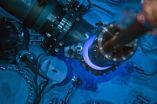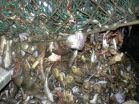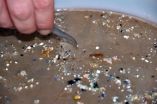(Press-News.org) This news release is available in German.
An international team of researchers, led by the University of Leicester, has solved a long-standing mystery in biology, by identifying the molecular structure of a vital biological chemical. The debate – which has raged within the scientific community for years – boils down to something as simple as a hydrogen atom: is it there, or is it not?
The controversy centres around a form of enzyme called a heme (or haem, as in haemoglobin) at the centre of which is an iron atom (Fe) called a 'ferryl' which becomes oxidised when a reacting heme is in an intermediate state called Compound I. The question that has taxed biological chemists for decades is whether this oxidation involves just an oxygen atom (O), or a hydroxyl group (OH). The difference being one hydrogen ion, or in other words, a proton.
Much has been written in the scientific literature about this ferryl heme, some scientists arguing that it carries a proton, while others have been equally adamant that no proton is present. Resolving this fundamental inconsistency has implications for understanding of oxidative processes within living cells, which is crucially important for drug development.
Professors Peter Moody and Emma Raven from the University of Leicester, working with neutron crystallography experts from the Institut Laue-Langevin in Grenoble, the Maier-Leibnitz Zentrum (MLZ) near Munich, and the University of Manchester have now solved the mystery of the ferryl heme Compound I structure using a method that has not previously been applied to this problem: neutron crystallography.
"Finding out where all the hydrogens are is key to understanding the way enzymes work," said Professor Moody. "The ability to capture intermediates at cryogenic temperatures combined with the information available from neutron crystallography, means that we can finally see them."
Structures of proteins are commonly determined using X-ray crystallography, in which X-rays are fired at a crystalline form of the protein and the resulting diffraction pattern can be used to calculate the molecular structure. While this process works fine in general, it cannot be used to identify the location of hydrogen atoms for various reasons. Neutron protein crystallography, a technique originally developed in the 1960s, uses neutrons instead of X-rays – which eliminates these problems and enables the detection of individual hydrogen atoms. The team used neutron cryo-crystallography, which has the additional complication of using very low temperatures to cryo-trap the enzyme intermediate.
And the answer turns out to be… the ferryl heme in Compound I is NOT protonated. But, unexpectedly, the results showed that one of the amino acid side chains (a histidine) on the molecule IS doubly protonated, which raises questions of its own in terms of mechanisms for oxygen activation in heme enzymes.
"The exact structure of ferryl heme has been a long and difficult problem for the heme community to resolve," said Professor Raven. "Through our collaborators in Grenoble and Munich, we have been lucky to have had access to excellent neutron beamlines in Europe, which has meant that we were in an excellent position to try new and different approaches that worked very nicely. The single crystal EPR experiments at Manchester were essential to help us verify the stability of the ferryl species."
The paper 'Neutron cryo-crystallography captures the protonation state of ferryl heme in a peroxidase' has now been published in Science.
INFORMATION:
Neutron crystallography resolves long-standing molecular mystery
Research has implications for understanding of oxidative processes within living cells which is crucially important for drug development
Leicester team worked with colleagues in France, Germany and Manchester
The research was supported by The Leverhulme Trust, BBSRC, The Wellcome Trust, Bruker UK Ltd, EU FP7, Institut Laue-Langevin and Heinz Maier-Leibnitz Zentrum.
International science team solve biological mystery
Debate over whether a single hydrogen atom exists is finally settled
2014-07-10
ELSE PRESS RELEASES FROM THIS DATE:
Overfishing in the English Channel leaves fisherman scraping the bottom of the barrel
2014-07-10
Decades of overfishing in the English Channel has resulted in the removal of many top predators from the sea and left fishermen 'scraping the barrel' for increasing amounts of shellfish to make up their catch.
Sharks, rays, cod, haddock and many other species at the head of the food chain are at historic lows with many removed from the area completely.
These are some of the findings of a study led by marine biologists at Plymouth University, in association with international non-profit research organization WorldFish. They analysed catches over the past 90 years and found ...
Uncertainty gives scientists new confidence in search for novel materials
2014-07-10
Scientists at Stanford University and the Department of Energy's SLAC National Accelerator Laboratory have found a way to estimate uncertainties in computer calculations that are widely used to speed the search for new materials for industry, electronics, energy, drug design and a host of other applications. The technique, reported in the July 11 issue of Science, should quickly be adopted in studies that produce some 30,000 scientific papers per year.
"Over the past 10 years our ability to calculate the properties of materials and chemicals, such as reactivity and mechanical ...
Scripps scientists discover evidence of super-fast deep earthquake
2014-07-10
As scientists learn more about earthquakes that rupture at fault zones near the planet's surface—and the mechanisms that trigger them—an even more intriguing earthquake mystery lies deeper in the planet.
Scientists at Scripps Institution of Oceanography at UC San Diego have discovered the first evidence that deep earthquakes, those breaking at more than 400 kilometers (250 miles) below Earth's surface, can rupture much faster than ordinary earthquakes. The finding gives seismologists new clues about the forces behind deep earthquakes as well as fast-breaking earthquakes ...
Leading scientists express rising concern about 'microplastics' in the ocean
2014-07-10
Microplastics – microscopic particles of plastic debris – are of increasing concern because of their widespread presence in the oceans and the potential physical and toxicological risks they pose to organisms.
This is the view of two of the world's most eminent authorities on the subject, Professor Kara Lavender Law, of Sea Education Association (Woods Hole, MA), and Professor Richard Thompson of Plymouth University (UK).
In an article published today in the journal Science, the two scientists have called for urgent action to "turn off the tap" and divert plastic waste ...
Control strategy for Dengue, malaria increases risk of West Nile virus
2014-07-10
Mosquitoes infected with the bacteria Wolbachia are more likely to become infected with West Nile virus and more likely to transmit the virus to humans, according to a team of researchers.
"Previous research has shown that Wolbachia -- a genus of bacteria that live inside mosquitoes -- render mosquitoes resistant to pathogen infection, thereby preventing the mosquitoes from infecting humans with the pathogens," said Jason Rasgon, associate professor of entomology, Penn State. "As a result, researchers are currently releasing Wolbachia-infected mosquitoes into the wild ...
New study shows drinking alcohol provides no heart health benefit
2014-07-10
PHILADELPHIA – Reducing the amount of alcoholic beverages consumed, even for light-to-moderate drinkers, may improve cardiovascular health, including a reduced risk of coronary heart disease, lower body mass index (BMI) and blood pressure, according to a new multi-center study published in The BMJ and co-led by the Perelman School of Medicine at the University of Pennsylvania. The latest findings call into question previous studies which suggest that consuming light-to-moderate amounts of alcohol (0.6-0.8 fluid ounces/day) may have a protective effect on cardiovascular ...
Study looks at how Twitter can be used to address specific health issues
2014-07-10
Childhood obesity is one of the top public health concerns in the United States, with 32 percent of youths aged 2-19 classified as obese as of 2012. As health problems such as childhood obesity grow, individuals and organizations have taken to Twitter to discuss the problem.
A new study, led by Jenine K. Harris, PhD, assistant professor at the Brown School at Washington University in St. Louis, examined the use of the hashtag #childhoodobesity in tweets to track Twitter conversations about the issue of overweight kids.
The study published this month in the American ...
Sophisticated radiation detector designed for broad public use
2014-07-10
CORVALLIS, Ore. – Nuclear engineers at Oregon State University have developed a small, portable and inexpensive radiation detection device that should help people all over the world better understand the radiation around them, its type and intensity, and whether or not it poses a health risk.
The device was developed in part due to public demand following the nuclear incident in Fukushima, Japan, in 2011, when many regional residents were unsure what level of radiation they were being exposed to and whether their homes, food, environment and drinking water were safe.
Devices ...
'Mississippi Baby' now has detectable HIV, researchers find
2014-07-10
The child known as the "Mississippi baby"—an infant seemingly cured of HIV that was reported as a case study of a prolonged remission of HIV infection in The New England Journal of Medicine last fall—now has detectable levels of HIV after more than two years of not taking antiretroviral therapy without evidence of virus, according to the pediatric HIV specialist and researchers involved in the case.
"Certainly, this is a disappointing turn of events for this young child, the medical staff involved in the child's care, and the HIV/AIDS research community," said NIAID ...
Your next Angry Birds opponent could be a robot
2014-07-10
With the help of a smart tablet and Angry Birds, children can now do something typically reserved for engineers and computer scientists: program a robot to learn new skills. The Georgia Institute of Technology project is designed to serve as a rehabilitation tool and to help kids with disabilities.
The researchers have paired a small humanoid robot with an Android tablet. Kids teach it how to play Angry Birds, dragging their finger on the tablet to whiz the bird across the screen. In the meantime, the robot watches what happens and records "snapshots" in its memory. ...
LAST 30 PRESS RELEASES:
Mount Sinai Health system receives $8.5 million NIH grant renewal to advance research on long-term outcomes in children with congenital heart disease
Researchers develop treatment for advanced prostate cancer that could eliminate severe side effects
Keck Medicine of USC names Christian Pass chief financial officer
Inflatable fabric robotic arm picks apples
MD Anderson and SOPHiA GENETICS announce strategic collaboration to accelerate AI-driven precision oncology
Oil residues can travel over 5,000 miles on ocean debris, study finds
Korea University researchers discover that cholesterol-lowering drug can overcome chemotherapy resistance in triple-negative breast cancer
Ushikuvirus: A newly discovered giant virus may offer clues to the origin of life
Boosting the cell’s own cleanup
Movement matters: Light activity led to better survival in diabetes, heart, kidney disease
Method developed to identify best treatment combinations for glioblastoma based on unique cellular targets
Self-guided behavioral app helps children with epilepsy sleep earlier
Higher consumption of food preservatives is associated with an increased risk of type 2 diabetes
NTU Singapore-led team captures first-ever ‘twitch’ of the eye’s night-vision cells as they detect light, paving the way for earlier detection of blindness-causing diseases
Global aviation emissions could be halved through maximising efficiency gains, new study shows
Fewer layovers, better-connected airports, more firm growth
Exposure to natural light improves metabolic health
As we age, immune cells protect the spinal cord
New expert guidance urges caution before surgery for patients with treatment-resistant constipation
Solar hydrogen can now be produced efficiently without the scarce metal platinum
Sleeping in on weekends may help boost teens’ mental health
Study: Teens use cellphones for an hour a day at school
After more than two years of war, Palestinian children are hungry, denied education and “like the living dead”
The untold story of life with Prader-Willi syndrome - according to the siblings who live it
How the parasite that ‘gave up sex’ found more hosts – and why its victory won’t last
When is it time to jump? The boiling frog problem of AI use in physics education
Twitter data reveals partisan divide in understanding why pollen season's getting worse
AI is quick but risky for updating old software
Revolutionizing biosecurity: new multi-omics framework to transform invasive species management
From ancient herb to modern medicine: new review unveils the multi-targeted healing potential of Borago officinalis
[Press-News.org] International science team solve biological mysteryDebate over whether a single hydrogen atom exists is finally settled






